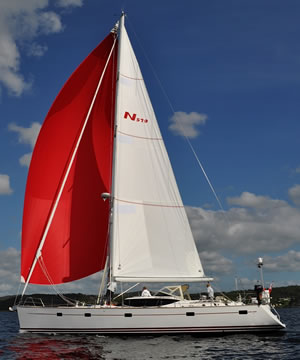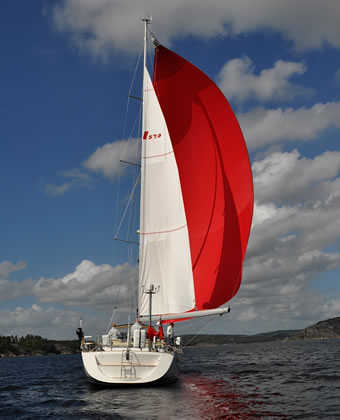The Asymmetric Spinnaker
 |
In my opinion, spinnakers are primarily for fully crewed racing yachts. Having said that, I think they can provide the cruising sailor with a lot of fun (as well as grief!) if flown in settled weather. Of course, there are the “young at heart” who are out for a blast but by and large, most cruising sailors refrain from sailing on the edge with a minimal crew, and with the advent of the Simbo Rig need not feel peer pressured into flying coloured sails. In fact, they will certainly hold there own at 20 knots TWS with considerably less concern, after which they can expect to leave their spinnaker driven comrades in their wake once the TWS increases to 25, 30 and 35 knots, without anxiety!
However, when reaching and running in light winds, one can substitute an asymmetric spinnaker for the Simbo Rig. I will fly this up to 15 knots TWS before recovering it with a well designed snuffer. On a reach, I straighten the luff by tightening the tack with a hauling line run through a turning block on the bowsprit/plank, to provide lift.
On bearing away to a run, I ease the downhaul to take the asymmetric forward. The sheet is re-run through a block attached above and to the outer end of the prevented main boom which then leads through a turning block on the capping rail and back to the cockpit winch.
 |
|---|
For this exercise, It is advisable to temporarily snuff the asymmetric to maintain control of what is otherwise a powerful flying sail. Finally a reef is put in the mainsail to allow the wind to flow over and around the leach to keep the asymmetric fully drawing. The mainsail's outhaul should be released to increase the draft and the boom eased to it's furthest run without allowing the sail to rest on the spreaders. This fully exposes the asymmetric spinnaker to the following wind.
Although the reduction in the mainsail gives some loss of drive, it is more than compensated by the fully powered asymmetric spinnaker which would otherwise have collapsed. Before snuffing the asymmetric, I unfurl the mainsail to blanket the spinnaker to ensure an easier retrieval. Another merit of the in-mast furling mainsail.
Although the asymmetric is a pleasing sail to fly, one must be careful not to let it spoil the experience by hanging on to it too long, especially if the increased wind has built up a sea which can make life on the foredeck hazardous.
With the availability of the Simbo Rig it is also unnecessary to fly the asymmetric spinnaker with TWS over 15 knots.
Return to Headsail Options |